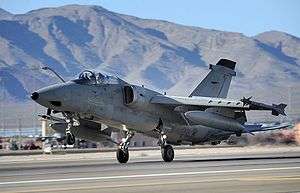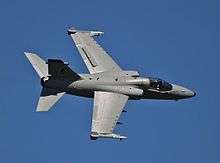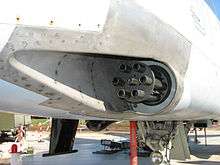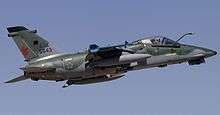AMX International AMX
| AMX | |
|---|---|
 | |
| Role | Ground-attack aircraft |
| National origin | Italy and Brazil |
| Manufacturer | AMX International |
| First flight | 15 May 1984 |
| Introduction | 1989 |
| Status | Active service |
| Primary users | Italian Air Force Brazilian Air Force |
| Produced | 1986–1999 |
| Number built | ~200 |
| Unit cost |
$16.5 million (1999)[1] |
The AMX International AMX is a ground-attack aircraft for battlefield interdiction, close air support and reconnaissance missions. As a result of a memorandum between Italy and Brazil for the type's joint development in 1981, AMX International, an Italian-Brazilian joint venture, was formed to develop, manufacture, and market the aircraft. The AMX is designated A-11 Ghibli by the Italian Air Force and A-1 by the Brazilian Air Force.
The AMX is capable of operating at high subsonic speed and low altitude, by day or night, and if necessary, from bases with poorly equipped or damaged runways. It possesses a low infrared (IR) signature and a reduced radar-equivalent cross-section to help prevent detection, while low vulnerability of structure and systems aid survivability and a compliment of integrated electronic countermeasures (ECM), air-to-air missiles and nose-mounted guns provide self-defence capabilities.
The Italian name, "Ghibli", is taken from the hot dry wind of the Libyan desert, and is traditional in the Italian Air Force.
Development
.jpg)
In early 1977, the Italian Air Force issued a requirement for 187 new-build strike fighters, which were to replace its existing Aeritalia G.91 in the close air support and reconnaissance missions, as well as the Lockheed RF-104G Starfighter also being used in the reconnaissance role.[2][3] Rather than competing for the contract, Aeritalia (now Alenia Aeronautica) and Aermacchi agreed to produce a joint proposal for the requirement, as both firms had been considering the development of a similar class of aircraft for some years. During the early 1970s, Aermacchi had been conducted work on a design study for such a light ground attack aircraft under the designation of MB-340. In April 1978, development work on the joint venture formally commenced.[4]
During 1980, the Brazilian government announced that they intended to participate in the program as a replacement for the Aermacchi MB-326. In July 1981, the Italian and Brazilian governments agreed on joint requirements for the aircraft, and Embraer was invited to join the industrial partnership.[4] An agreement was also struck to divide AMX manufacturing between the partners; for each production aircraft, Aeritalia manufactured 46.5% of the components (central fuselage, stabilisers and rudders), Aermacchi produced 22.8% (front fuselage and tail cone), and Embraer performed 29.7% of the work (wing, air intakes, pylons and drop tanks).[2] There was no duplication of work, each component of the aircraft was built at one source only. The planned requirements were 187 aircraft for Italy and 100 for Brazil.[3]
In the early stages of development, various different powerplants and engine configurations were studied to power the type; both twin-engine and single-engine approaches were considered. The use of US-sourced engines had been promptly discounted to avoid any potential restrictions on export sales of the overall aircraft.[3] Amongst the engines examined were the Turbo-Union RB199 (as used by the larger Panavia Tornado), the Rolls-Royce Turbomeca Adour, Rolls-Royce Viper, and the Rolls-Royce Spey engine.[3] In 1978, the Spey 807 model, which featured several additional improvements, was selected to power the new aircraft.[3]
Key features that were reportedly emphasised in the design process of the new aircraft were accessibility and survivability; the AMX had to be able to sustain a single failure to any onboard system without any performance degradation.[3] To achieve this, key systems are duplicated and vital systems are protected; the use of cockpit armor was considered but ultimately discounted due to the expense involved.[3] The detailed definition phase of the project was completed in March 1980.[2]
A total of seven flight-capable prototypes were produced for the test program, three by Aeritalia, two by Aermacchi, and two by Embraer, as well as two static airframes. The first prototype, assembled in Italy, made its maiden flight on 15 May 1984. This first aircraft was lost on its fifth flight in an accident, resulting in the death of its pilot.[5] Aside from this early loss, testing progressed smoothly and without further incident.[6] The first Brazilian-assembled prototype made its first flight on 16 October 1985. On 11 May 1988, the first production aircraft performed its first flight.[7] Deliveries of production aircraft to Italy began in 1988,[5] the first examples were delivered to the Brazilian Air Force during the following year.[8] On 14 March 1990, the prototype two-seat AMX made its first flight.[7]
Design
.jpg)
The AMX has a conventional shoulder-winged monoplane. It is composed primarily of aluminium and manufactured using traditional construction methods, however elements such as the tail fin and elevators use carbon fibre composite materials.[2] For its size, a large proportion of the AMX's internal space is allocated to avionics and onboard computer systems, both the navigation and attack systems are computerized.[9] For accessibly and ease of maintenance, all avionics are installed directly in bays beneath the cockpit in a manner in which they can be worked upon at ground level without the use of support platforms.[3]
Drawing on experience from the Panavia Tornado, the AMX is equipped with a hybrid flight control system; a fly-by-wire control system is employed to operate flight control surfaces such as the spoilers, rudder and variable incidence tailplane, while the ailerons and elevators are actuated via a dual-redundant hydraulic system. Manual reversion is provided for the ailerons, elevator and rudder to allow the aircraft to be flown even in the event of complete hydraulic failure; either control system can act independent of one another.[10][11] The wing is fitted with both leading edge slats and trailing edge flaps and overwing spoilers ahead of the flaps. The spoilers can function as airbrakes and to negate lift; improving take-off and landing performance as well as manoeuvrability during flight.[12]
A single Rolls-Royce Spey turbofan engine serves as the AMX's powerplant. During the aircraft's development, the Spey was heavier and less modern than some of the available alternatives, but it was considered to be reliable, relatively cheap and was free of export restrictions that would be imposed by using American engines.[3][13] The Spey engine also enabled for the use of a simplified round-lipped inlet design. The rear fuselage is detachable in order to gain access to the engine. Separate consortia in both Brazil and Italy manufactured the Spey for the AMX.[12] Unusual for a strike aircraft of the era, no attempt was made to develop the aircraft to fly at supersonic speeds.[2]
Brazilian and Italian aircraft differ considerably in their avionics, Italian aircraft being equipped with various NATO systems which were considered redundant in the South American theatre.[9] AMXs in Brazilian service are often fitted with one of three pallet-mounted sensor packages, which contain various vertical, oblique, and forward-facing cameras, for performing the aircraft's secondary aerial reconnaissance role.[7][9] A simple ranging radar is equipped for targeting purposes, however the specific radar also differs between both operators.[12] The flight system employs a GE Avionics flight control computer.[14] Extensive electronic countermeasure (ECM) are fitted to protect the aircraft, include passive receiver antenna on the tailfin and an active jammer pod that is typically mounted on one of the aircraft's hardpoints.[12]
Various munitions could be mounted on the one centerline and four under-wing hardpoints, including bombs, missiles and rockets; payloads of up to 2,000 lb may be carried upon the centerline and the two innermost under-wing pylons, while the outer pylons can carry up to 1,000 lb.[9] All four of the under-wing hardpoints are plumbed for drop tanks to extend the aircraft's range, Italian aircraft are also fitted with a fixed aerial refueling probe.[12] Optical reconnaissance pods can be carried externally on the centerline hardpoint.[7] Wingtip rails are provided for infrared guided air-to-air missiles such as the AIM-9 Sidewinder and MAA-1 Piranha. Italian aircraft are fitted with a M61 Vulcan 20 mm rotary cannon on the port side of the lower fuselage.[9] The United States denied the sale of the M61 to Brazil, thus its AMXs are instead fitted with two 30 mm DEFA 554 revolver cannons.[10][15]
Operational history

The first operational squadron of the Italian air force, the 103° Gruppo of 51° Stormo formed in November 1989,[16] with the first Italian unit also forming in 1989.[17] Both the Italian and Brazilian AMX fleets were grounded in February 1992, following the crash of an Italian AMX due to engine failure. Operations were allowed to restart in May that year, following modification of the engines.[18][19]
Italy assigned six AMXs from 103° Gruppo to operations over Bosnia in 1995 as part of Operation Deny Flight, which was followed by a similar deployment in support of the IFOR peacekeepers in Bosnia. This deployment was interrupted by another grounding, again due to engine failure, between January and March 1996.[20] Italian AMX aircraft were used in 1999 in the Kosovo war. Instead of using unguided or more traditional laser-guided bombs, the Italian Air Force used dozens of Mk 82 bombs fitted with Opher Israeli guidance kits, effectively converting the "dumb" bombs into an infrared-guided bomb.[21]
In the late 1990s, AMX International was considering a major engine refit; a non-afterburning variant of the Eurojet EJ200 was proposed, with considerably more thrust than the existing powerplant.[22] In 2005, the Italian Air Force launched an upgrade programme (ACOL Aggionamento Capacità Operative e Logistiche – Operational and Logistical Capability Upgrade) for 55 of its AMXs,[23] adding a new laser INS, new cockpit displays and allowing the aircraft to drop Joint Direct Attack Munition guided bombs.[24] In August 2007, Embraer began a major midlife upgrade programme and modernisation of 53 Brazilian Air Force AMX A-1s, focusing on avionics systems and new armament additions; the programme is estimated to have extended the lifespan of the fleet beyond 2027.[25]

Starting in November 2009, four Italian AMXs were deployed overseas for operations in Afghanistan, replacing the same number of Italian Tornado IDS in the reconnaissance role.[26] Of particular note is the aircraft's ability to share digital electro-optical and infrared sensor information with ground troops in real time, providing valuable reconnaissance information and helping to minimise threat exposure. By the end of 2010 over 700 combat missions had been flown in the Afghan theatre. On 28 May 2014, the AMX performed its last combat sortie in the Afghan theatre, and on 20 June 2014, all remaining AMXs were withdrawn from Afghanistan.[27]
In 2011, Italian AMX aircraft were employed during the 2011 military intervention in Libya. Italian military aircraft deployed 710 guided bombs and missiles during sorties: Italian Air Force Tornados and AMX fighter bombers deployed 550 bombs and missiles, while Navy AV-8Bs deployed 160 guided bombs. The conflict saw the first use by AMX aircraft of Litening targeting pods paired with Paveway and JDAM guided bombs.[28] In early 2016, due to the declining stability of Libya, Italy opted to station additional aircraft, including four AMX fighters, to Bassi Airbase, Trapani, Sicily.[29]
In March 2012, the Philippines was reportedly holding negotiations with Italy for the possible procurement of used AMX aircraft;[30] however, on 28 March 2014, the Philippines' Department of National Defense signed a contract for 12 FA-50 light attack aircraft worth P18.9 billion (US$421.12 million).[31][32]
Variants
|
| |
|
| |
|
| |
|
| |
|
|
- AMX-T
In 1986, development of a two-seat advanced trainer variant was undertaken. This was intended to provide trainee pilots with experience on fast jets, while still retaining the single-seater's attack capabilities. First flying in 1990, the AMX-T equipped both the Italian and Brazilian air forces.
- AMX-ATA
The AMX Advanced Trainer Attack (AMX-ATA) is a new AMX two-seater multi-mission attack fighter developed for combat roles and advanced training. The AMX-ATA incorporates new sensors, a forward-looking infrared helmet-mounted display, a new multi-mode radar for air-to-air and air-to-surface capability, and new weapons systems including anti-ship missiles and medium-range missiles. The Venezuelan Air Force ordered eight AMX-ATA in 1999 for the advanced trainer and attack aircraft role, but the US Congress vetoed the sale because the aircraft systems include US technology.[33][34]
- AMX-R (RA-1)
An AMX variant designed for reconnaissance missions. Various reconnaissance pallets can be fitted; used by the Brazilian Air Force.
- A-1M
The product of a Brazilian upgrade program of their A-1s; significant features include a Mectron SCP-01 Scipio radar,[35] Embraer BR2 data link, FLIR Systems navigation equipment,[36] Elbit INS/GPS/databus, the adoption of a glass cockpit,[37] a new OBOGS system and HMD DASH IV.
- A-11A
Italian military designation for the AMX from 2012.[38]
- TA-11A
Italian military designation for the AMX-T from 2012.[38]
- A-11B
Italian military designation for the AMX ACOL from 2012.[38]
- TA-11B
Italian military designation for the AMX-T ACOL from 2012.[38]
Operators
- Brazilian Air Force operates 60 AMX-A/T (including eight AMX-T for training).[39] 43 aircraft to be modernized to A-1M, delivered between 2013 and 2017, and to be retired in 2032.[40]
- 1 Esquadrão/16 Grupo de Aviação Esquadrão Adelphi
- 1 Esquadrão/10 Grupo de Aviação Esquadrão Poker
- 3 Esquadrão/10 Grupo de aviação Esquadrão Centauro
- Italian Air Force operates 35× A-11B (originally AMX ACOL) and 11× TA-11B (originally AMX-T ACOL) (out of four prototypes, 110 one-seaters and 26 two-seaters delivered)
- 101 Gruppo, 51 Stormo (Training Squadron operating 11× AMX-T ACOL) - were disbanded
- 103 Gruppo, 51 Stormo (Ground Attack Squadron 18× AMX ACOL) - were disbanded
- 132 Gruppo, 51 Stormo (Ground Attack Reconnaissance Squadron 17× AMX ACOL with the RecceLite Pod from Rafael)
Aircraft on display
- A former Italian Air Force AMX is displayed on a pedestal in front of the Thales Alenia Space plant in Turin[41]
Specifications (AMX)
.png)
_(2).jpg)

Data from Jane's All The World's Aircraft 1993–94,[10] Jet Bombers[42]
General characteristics
- Crew: 1
- Length: 13.23 m (43 ft 5 in)
- Wingspan: 8.87 m (29 ft 1 1⁄2 in)
- Height: 4.55 m (14 ft 11 1⁄4 in)
- Wing area: 21.0 m² (226 ft²)
- Aspect ratio: 3.75:1
- Empty weight: 6,700 kg (14,771 lb)
- Loaded weight: 10,750 kg (23,700 lb)
- Max. takeoff weight: 13,000 kg (28,700 lb)
- Powerplant: 1 × Rolls-Royce Spey 807 turbofan, 49.1 kN (11,030 lbf)
- Internal fuel capacity: 3,555l (2,700kg) internal.
- External fuel capacity: 2x 1,000l (760kg) in inner wing and 2x 500l (380kg) in outer wing.[43]
Performance
- Maximum speed: 1053 km/h (568 knots, 654 mph) at 10,975 m (36,000 ft)[44]
- Combat radius: 889 km (480 nmi, 553 mi) (hi-lo-hi profile, 900 kg (2,000 lb) of external stores)
- Ferry range: 3,336 km (1,800 nmi, 2,073 mi)
- Endurance: 4h 15min[45]
- Service ceiling: 13,000 m (42,650 ft)
- Rate of climb: 52.1 m/s (10,250 ft/min)
- Wing loading: 512 kg/m² (105 lb/ft²)
- Thrust/weight: 0.47
Armament
- Guns:
- 1× 20 mm (0.787 in) M61A1 Vulcan 6-barreled Gatling cannon (Italian aircraft)
- 2× 30 mm (1.181 in) Bernardini Mk-164 cannon (Brazilian aircraft)
- Missiles: 2× AIM-9 Sidewinders or MAA-1 Piranhas or MAA-1B Piranha II (under development) or A-Darter (under development),[46] carried on wingtip rails
- Bombs: 3,800 kg (8,380 lb) on 5 external hardpoints, including MAR-1[47] missiles, general-purpose and laser-guided bombs, air-to-ground missiles, and rockets
See also
- Aircraft of comparable role, configuration and era
- Related lists
References
Citations
- ↑ "Alenia/Aermacchi/Embraer AMX - Archived 02/2008." Forecast International, February 2007.
- 1 2 3 4 5 Gunston and Gilchrist 1993, p. 289.
- 1 2 3 4 5 6 7 8 9 Warwick 1981, p. 1544.
- 1 2 Braybrook 1989, p. 267.
- 1 2 Braybrook 1989, p. 275.
- ↑ Meitus 1992, pp. 223–224.
- 1 2 3 4 Gunston and Gilchrist 1993, p. 291.
- ↑ Lambert 1993, p. 126.
- 1 2 3 4 5 Warwick 1981, p. 1545.
- 1 2 3 Lambert 1993, pp. 129–131.
- ↑ Warwick 1981, pp. 1544–1545.
- 1 2 3 4 5 Gunston and Gilchrist 1993, p. 290.
- ↑ Braybrook 1989, p. 270.
- ↑ Gunston and Gilchrist 1993, pp. 289-290.
- ↑ Jackson 1991, p. 135.
- ↑ Nicolli 1997, p. 351.
- ↑ Jackson 1991, p. 138.
- ↑ Nicolli 1997, pp. 351–352.
- ↑ "Brazil and Italy lift AMX Ban". Flight International, 6–12 May 1992, p. 14.
- ↑ Nicolli 1997, p. 352.
- ↑ "Opher bomb deployed in Kosovo". Flight Global.
- ↑ Norris, Guy. "EJ200 engine proposed for AMX." Flight International, 20 April 1999.
- ↑ "Alenia lands $390m AMX upgrade contract". Flight International. Flight Global. 8 February 2005. Retrieved 7 November 2009.
- ↑ Niccoli 2009, p.44.
- ↑ Gething, Michael J. "Embraer commences AMX modifications for the Brazilian Air Force." Jane's, 9 June 2007.
- ↑ Peruzzi, Luca. "Italy's JATF in Afghanistan boosts air-to-ground and C-IED capabilities." Jane's, 9 November 2012.
- ↑ "Italian Air Force: a year of missions for the AMX airplanes in Afghanistan." AvioNews, 3 December 2010.
- ↑ Kingston, Tom (14 December 2011). "Italy Gives Bombing Stats for Libya Campaign". Defense News.
- ↑ "Italy Sends Fighter Aircraft to Birgi Base Amid Concerns Over Libya." Sputnik News, 16 January 2016.
- ↑ "DND signs five-year agreement with Italy". The Philippine Star. 8 February 2012. Retrieved 20 February 2012.
- ↑ "KAI won a contract to export 12 FA-50s to the Phil". Korea Aerospace Industries, LTD. (KAI). 2014-03-28. Retrieved 29 November 2015.
- ↑ "Korean government to sell 12 FA-50 fighter jets to Philippines". Arirang News. 28 March 2014. Retrieved 29 November 2015.
- ↑ Spinelli, Andrea. "Venezuela selects MB339FD and AMX ATA combination." Flight International, 15 July 1998.
- ↑ "Military Aircraft Directory: AMX." Flight International, 29 July 1998.
- ↑ "Embraer lucra com retrofit de aviões" [Embraer profits from aircraft retrofit], Estadão (in Portuguese), 16 September 2011, retrieved 29 January 2012.
- ↑ "FLIR Systems wins $7 million contract from Embraer", Military Aero Space, 9 June 2009, retrieved 29 January 2012.
- ↑ "Elbit consegue contrato de US$187 mi da Embraer" [Elbit gets US$ 187 mi contract with Embraer], Reuters (in Portuguese), 11 November 2009, retrieved 29 January 2012.
- 1 2 3 4 "Utilizzo della Nomenclatura 'Mission Design Series' (MDS) neele Pubblicazioni Tecniche (PPTT) di Competenza della Daa" [Usage of the ‘Mission design series’ (MDS) designation in the technical publications (PTT) under Daa’s competence] (PDF) (in Italian). Ministero Della Defesa. June 2011.
- ↑ "World Airliner Census 2011". Flight Global," 13–19 December 2011. Retrieved: 10 January 2012
- ↑ "FAB ganha poder de fogo com 'novo' caça" (in Portuguese). Archived 29 January 2012 at the Wayback Machine. Estadao, 16 January 2012. Retrieved: 16 January 2012.
- ↑ https://www.google.it/maps/place/Strada+Antica+di+Collegno,+253,+10146+Torino/@45.0820987,7.6117471,136m/data=!3m1!1e3!4m2!3m1!1s0x47886b7fc3ad006f:0x667334df0dc3663e
- ↑ Gunston and Gilchrist 1993, p. 292.
- ↑ "Aeritalia-Embraer-Aermacchi AMX". fighter-planes.com. Retrieved: 9 February 2012,
- ↑ Donald and Lake 1996, p. 31.
- ↑ "Directory: Military Aircraft". Flight Global, 21–25 May 2004. Retrieved: 2 February 2012.
- ↑ "South Africa, Brazil to Develop A-Darter SRAAM". Defense Industry Daily, 26 April 2010. Retrieved: 29 December 2012.
- ↑ "Defesa ganha mais espaço na Odebrecht" (in Portuguese). Archived 6 June 2013 at the Wayback Machine. Estadão, 8 April 2011. Retrieved: 29 January 2012.
Bibliography
- Air International. "Italy's Black Cats." February 2015, Key Publishing. pp. 64–69.
- Braybrook, Roy. "Assessing the AMX". Air International, June 1989, Vol 36 No 6. Bromley, UK:Fine Scroll. ISSN 0306-5634. pp. 267–278.
- Donald, David and Jon Lake. Encyclopedia of World Military Aircraft. London: Aerospace Publishing, Single Volume Edition, 1996. ISBN 1-874023-95-6.
- Gunston, Bill and Peter Gilchrist. Jet Bombers: From the Messerschmitt Me 262 to the Stealth B-2. Osprey, 1993. ISBN 1-85532-258-7.
- Jackson, Paul. "AMX: The 'Pocket Tornado'". World Air Power Journal. Volume 5, Spring 1991. ISSN 0959-7050. pp. 132–139.
- Lambert, Mark. Jane's All The World's Aircraft 1993–94. Coulsdon, Surry, UK: Jane's Data Division, 1993. ISBN 0-7106-1066-1.
- Metius, Wojtek. "AMX IOC: Service use for Italy's new agile attacker". Air International, October 1992, Vol 43 No 4. Stamford, UK:Key Publishing. ISSN 0306-5634. pp. 222–225.
- Niccoli, Ricardo. "AMX In Italian Service". Air International, June 1997, Vol 52 No 6. Stamford, UK:Key Publishing. ISSN 0306-5634. pp. 349–353.
- Niccoli, Ricardo. "AMX: Upgraded and Ready for Combat". Air International, November 2009, Vol 77 No 5. Stamford, UK:Key Publishing. ISSN 0306-5634. pp. 42–45.
- Warwick, Graham. "AMX design reflects Tornado experience". Flight International, 21 November 1981. pp. 1544–1545.
External links
| Wikimedia Commons has media related to AMX International AMX. |
